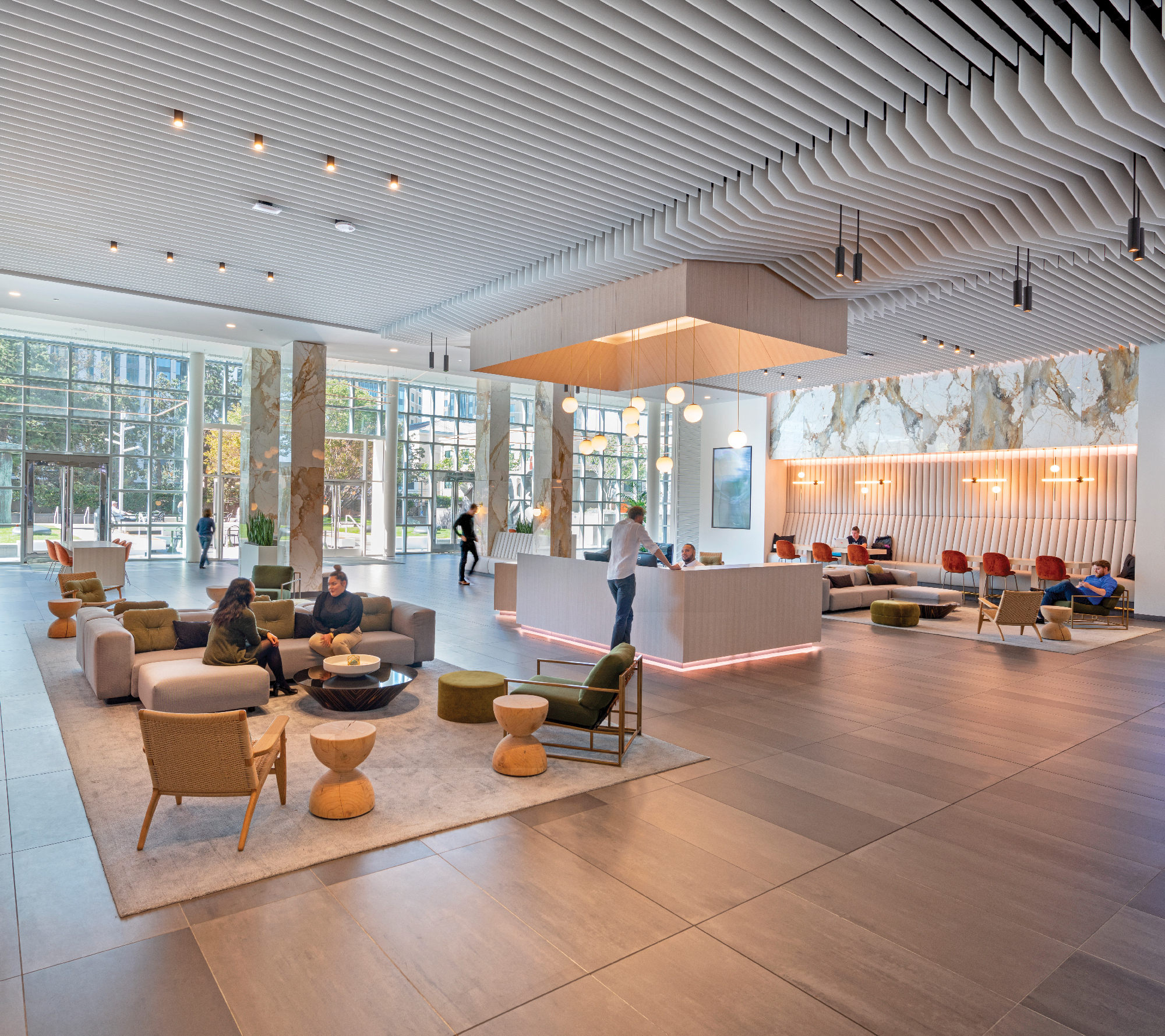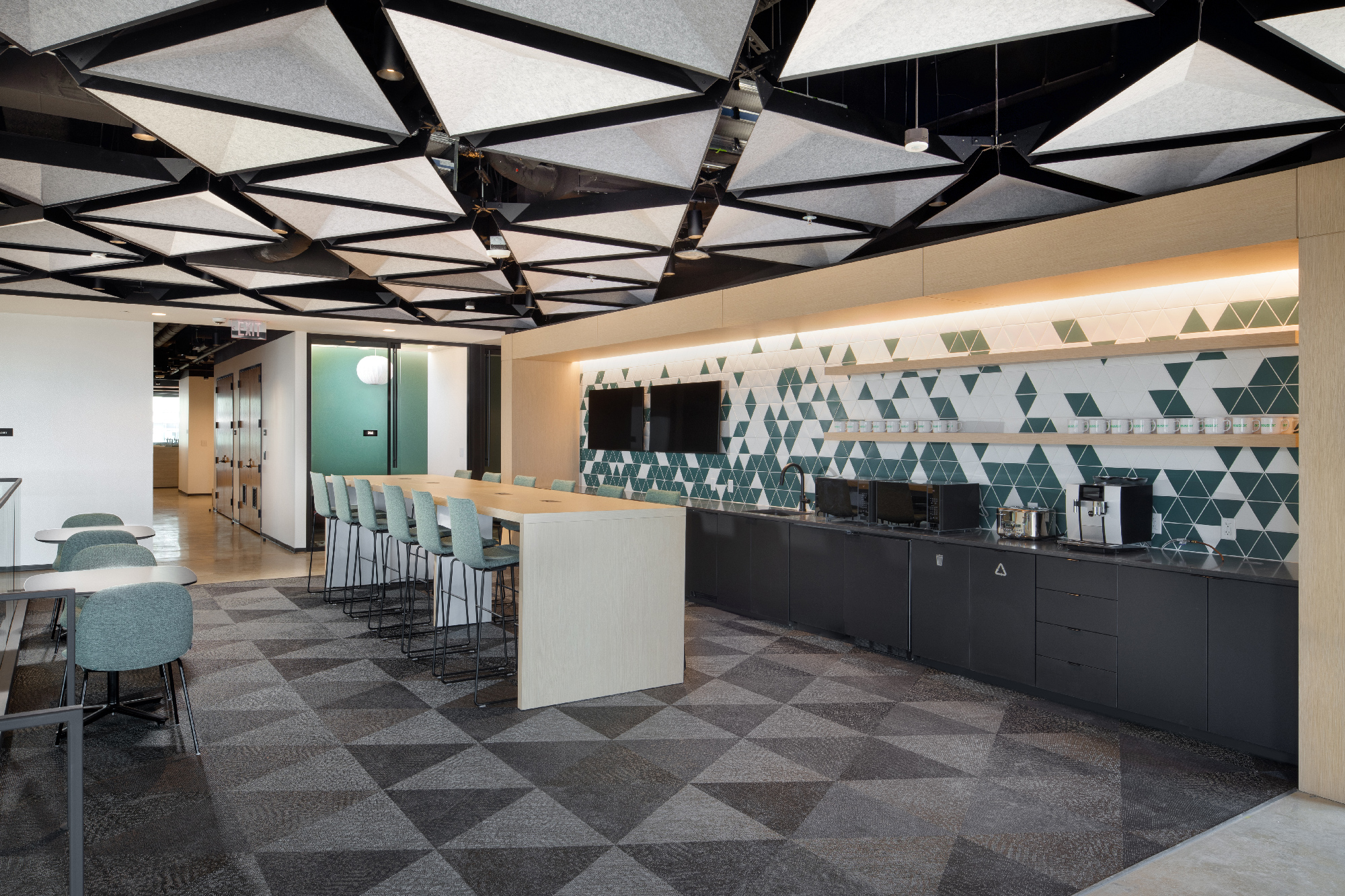Custom Ceiling Design
Learning Objectives:
- Identify and recognize the characteristics of ceiling systems that can contribute to comfort, health, and general welfare for occupants.
- Investigate the principles of acoustical comfort as they apply to the health and welfare of people in buildings.
- Assess the ways to integrate the different aspects of custom ceiling design into a coordinated solution for improved indoor environments.
- Specify fully integrated systems in a variety of green and conventional buildings and formulate appropriate selections related to specific applications.
Credits:
This course is approved as a Structured Course
This course can be self-reported to the AANB, as per their CE Guidelines
Approved for structured learning
Approved for Core Learning
This course can be self-reported to the NLAA
Course may qualify for Learning Hours with NWTAA
Course eligible for OAA Learning Hours
This course is approved as a core course
This course can be self-reported for Learning Units to the Architectural Institute of British Columbia

Photo by Jasper Sanidad. “1111 Broadway” Oakland, CA, Rios Clementi Hale Studios
Ceilings can provide a significant design element when they are customized to suit an interior space for an enhanced experience.
The design of building interiors is often focused on walls, floors, and furnishings perhaps because of a perception that these are where people interact most with the indoor environment. However, just as we experience a beautiful sky outdoors, the design of a ceiling indoors can have a significant impact on the look, feel, and character of an interior space. This happens because people react to more than just the visual aspects of a ceiling, which, while important, belies the other ways we interact and perceive spaces. This includes the impact of a ceiling on acoustics in a space, on achieving a sense of either motion or stillness or creating a benign or dramatic experience. This course covers many of these different aspects of ceiling design and the ways that they can be customized to suit many different design goals in all types of buildings.
CEILING SYSTEMS AS PART OF INTERIOR DESIGN
Ceilings in commercial and institutional buildings don’t need to be boring. For a lot of years, the norm has been to assume the use of a suspended ceiling with a rectilinear grid and white acoustical tile. Manufacturers have offered some innovations over time, but they have mostly been two-dimensional solutions, nonetheless. More recently, some three-dimensional options have emerged with a variety of aesthetic and performance features and capabilities. As the appeal for high-performance, high-visual impact ceilings has grown, and the costs have become more competitive, there are more options for ceilings to be part of an overall interior design scheme than ever before.
One current aspect of ceiling design is that it can be customized to suit the specific needs of a project. Systems are available that use standardized components to create custom appearances as well as the possibility of creating custom pieces from some manufacturers. In so doing, these advanced ceiling systems provide a full range of features and capabilities as part of the overall design of spaces and rooms. Among the possibilities, the following is a representative list:
- Acoustics: Suspended ceilings have always been a reliable means to provide acoustic comfort for people in different conditions and in all building types. The key to a successful acoustical design is to select and design a ceiling system that has the best acoustical properties for a particular space. Not all conditions are the same, so an improper selection or design can provide disappointing or unwelcome results.
- Visuals: Ceilings, custom or otherwise, can be designed not only for pure aesthetic appearance but also to induce occupant health and well-being. This can be achieved through color and pattern selection creating spaces that promote relaxation and reduce stress.
- Biophilia: Ceilings can be customized to incorporate three-dimensional organic shapes inspired by nature. This reflection or mimicry of nature can be achieved through shapes, colors, and patterns of ceiling components. Such an approach can be specific to particular rooms or part of an overall building design.
- Lighting: The incorporation of integrated lighting into ceilings has been a mainstay of suspended ceiling design and layout. Customized ceiling designs can also incorporate customized lighting options, particularly with alternatives to standard lay-in lighting fixtures.
By paying attention to these different aspects of ceiling design, building interiors can be enhanced for people experiencing a space, address multiple human senses, and contribute to health and wellness.

Photo: Jenn Verrier
Customized ceilings can creatively enhance the experience of being in an interior space. Project: Neustar; Location: Reston, Virginia; Architect: HKS Architects
ACOUSTIC COMFORT FROM CEILINGS
As noted, one of the primary functions that ceilings provide in many situations is acoustical control for the comfort and benefit of those who are in the rooms and spaces of a building. In order to understand some of the ways in which ceilings can enhance or detract from acoustical performance, the following principles are presented as a basis for good design.
Acoustical Energy
Sound is energy that radiates out from a source, just like heat and light are radiative energy. Understanding how to direct, restrict, or otherwise control sound is similar to how we do the same with other types of energy.
In the case of interior acoustics, design strategies focus on what happens when sound waves travel into or through a space and meet a surface such as a ceiling. The particular effect that surface will have on the emitted sound waves will depend directly on the acoustic characteristics of the material encountered. All materials, however, will exhibit differing levels of the same three actions:
- Reflection: Some percentage of the sound will bounce off of the surface and be reflected back into the space. If the material is highly reflective, it will make this condition severe causing echoes or seemingly intensified sound levels. While this might be desirable in some situations, it is not common for most commercial and institutional settings.
- Absorption: When ceiling materials are softer and porous, they are very good at absorbing sound waves and dissipating the energy. This has the effect of softening the sound and reducing echoes, making it easier to understand conversation and other sounds.
- Transmittance: When some of the sound energy is not reflected or absorbed by a ceiling, it is directly transmitted through the ceiling material or the assembly to the other side. This means that people in adjacent spaces may hear what is going on “next door” or on a floor above or below the source of the transmitted sound.
Note that these three characteristics of sound are true for all conditions and with all materials. We focus our attention only on ceilings here.

Images courtesy of Arktura
In order to predict and control acoustic performance in buildings, many different aspects of sound need to be taken into account.
Acoustical Performance
Understanding the basic ways that sound behaves when it encounters different materials or assemblies is the starting point. The next logical question is how much of each occurs. By using standard methods of measuring or testing materials and assemblies, their acoustical properties can be quantified. This information can be used to help control, direct, or reduce the sound experienced in well-designed spaces. The common means to measure sound reflectance, absorption, and transmission are as follows:
- Noise Reduction Coefficient (NRC): Individual materials can be formally tested according to ASTM C423 “Standard Test Method for Sound Absorption and Sound Absorption Coefficients by the Reverberation Room Method.” This standard is used to measure the rate of sound absorption of materials on a scale of zero to one. As such, NRC ratings of a material are commonly viewed as a percentage. For example, an NRC of 0.75 means 75% of the sound energy that strikes a tested material is absorbed instead of being reflected or transmitted.
- NRC vs. Sound Absorption Average (SAA): The NRC rating is the average of the sound absorption coefficients of four specific sound frequencies: 250, 500, 1000, and 2000hz.By contrast, the Sound Absorption Average (SAA) rating is the average of the sound absorption coefficients of an octave range that includes 12 different frequencies between 200 and 2500 Hz, thus providing a more complete understanding of sound performance. In both the NRC and the SAA tests, the scale of results goes from 0 (perfect reflection/ no absorption) to 1 (perfect absorption/ no reflection). This scale is used to measure the effectiveness of ceiling tiles, baffles, and other acoustic design elements. Depending on the test setup, some results can exceed 1. When acoustical ceiling products are tested, they generally are designed to achieve very high NRC and/or SAA ratings. However, those results will vary based on the circumstances of how it is used, the thickness and makeup of the materials, and variations between products.
- Sabin: When acoustic materials are placed to hang down vertically in a space instead of horizontally on a ceiling, then a different sound measurement is needed. In this case, a Sabin is used as the measure of the total sound absorption provided by an individual sound absorber such as a ceiling baffle when installed within an architectural space. Absorption in Sabin is also measured according to ASTM C423. The number of Sabin per unit is approximately equal to the total surface area of the unit (in square feet) that is exposed to sound, multiplied by the measured absorption coefficient of the material. Some ceiling products are ideal for this type of application and commonly show test results with a very high absorption coefficient and Sabin ratings.
- Sound Transmission Class (STC): This is a standard test rating that is often provided by manufacturers as a means for designers to select appropriate materials for sound transmittance in buildings. Essentially, the STC rating is a way to determine how much sound (measured in decibels) is reduced as it passes through a material or assembly. The higher the STC rating, the more sound that does not transmit. For most building conditions, an STC rating on the order of 40 – 45 is appropriate for most normal conditions but ranges between 35 and 55 are also common. For ceiling design, the STC rating should be used to measure the sound that is being transmitted through the entire ceiling assembly, not just an individual ceiling product.

















